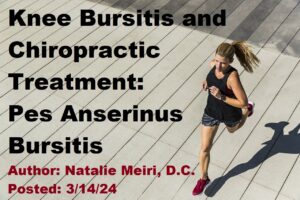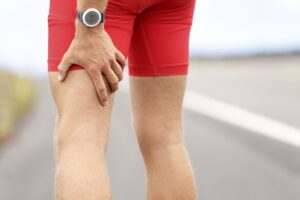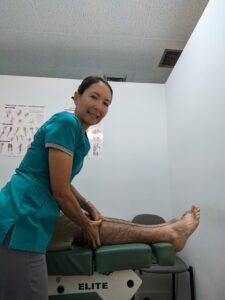
If you have knee pain from Pes Anserinus Bursitis, Chiropractic can provide relief! This post is about Knee Bursitis and Chiropractic Treatment: Pes Anserinus Bursitis.
What is bursitis?
Bursae are fluid-filled, sac like cavities. Bursae are located where muscles and tendons move over bony joint areas. They reduce friction caused by muscles and tendons moving against skin and bones. Also, they facilitate movement.
A knee bursa is like a cushion. So when one becomes inflamed, increased tension and pain can occur in a condition known as bursitis. The bursa in the knee increases with fluid and redness in the area it occurs.
Where is the Pes Anserinus and the bursa?
The pes anserinus is composed of the combination of tendinous insertions of the sartorius, gracilis, and semitendinosus muscles:
- sartorius– long, thin, superficial muscle that runs down the length of the thigh in the anterior (front) compartment
- gracilis– muscle descends almost vertically down the leg and inserts on the medial tibia at the Pes anserinus
- semitendinosus– is one of the three muscles that make up the hamstrings muscle group, and it is located at the posterior (back) and medial (inner) aspect of the thigh.
The pes anserinus bursa lies about 2 inches below the medial knee joint line between the pes anserinus (bracilis, sartorius, and semitendinousus muscles) above and the medial collateral ligament and anterior tibia (front of shinbone) below.

Causes of Pes Anserinus Bursitis
Firstly, one possible cause is over training such as excessive miles, excessive hills, and improper or inadequate stretching. This can lead to shortened medial hamstrings which may compress the bursa with overuse.
Secondly, knee valgus (Knock knee) and heel valgus (heel to drift outwards) may also lead to pes anserinus bursitis.
Thirdly, external tibial torsion (leg turns outward), femoral anteversion (inward twisting of the thigh bone) and a broad pelvis (in women) can cause pes anserinus bursitis.
Fourthly, if you have knee osteoarthritis, there’s a 75% chance of also having pes anserinus bursitis.
Fifthly, it occurs more often in 50-80 year old women especially if overweight.
Finally, it is also found in runners and soccer players.
Symptoms and Signs of a Pes Anserinus Bursitis
You may have pain that occurs with walking up stairs. This may occur in the early stages of training or later stages of use (distance running). Furthermore, you usually will have pinpoint tenderness 2 inches below the medial (inner) knee joint line. And there may be moderate swelling. Also, your pain may radiate into the medial (inner) knee joint and along the medial (inner) hamstring.

Treatment for Pes Anserinus Bursitis at Meiri Chiropractic
First, biomechanical evaluation of the lower extremity regarding torsion and angulation is necessary.
Second, chiropractic manipulative therapy (adjustments) is rendered to the knee and associated spine and extremity (limb) joints.
Third, manipulation of muscle contractures with soft tissue techniques is utilized. Some Techniques include gentle PNF/PIR (e.g. post isometric relaxation) and/or myofascial release techniques.
Finally, therapeutic exercises for rehabilitation/ strengthening are prescribed. Flexibility and strengthening of the hamstrings, gastrocnemius and soleus are important. And corrective shoes or orthotics for heel and knee valgus maybe necessary.
Getting regular chiropractic treatment at a chiropractic center in West Palm Beach can help naturally relieve the pain and dysfunction of the knee. Chiropractic is a holistic and natural way to not only treat existing conditions, but to keep your body in its best working condition.
Contact Meiri Chiropractic today at 561-253-8984 to make an appointment or to learn more about Knee Bursitis and Chiropractic Treatment: Pes Anserinus Bursitis.